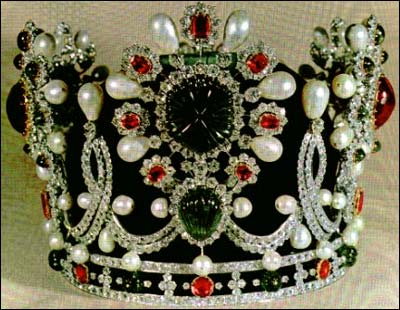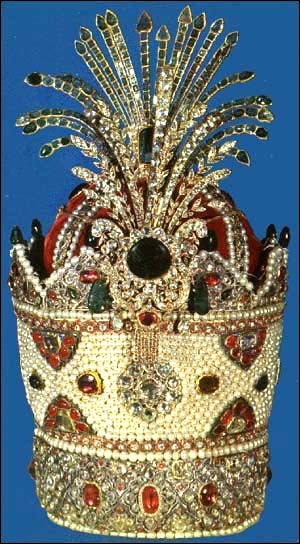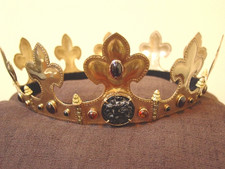Crown
Show your Fealty to the Crown!
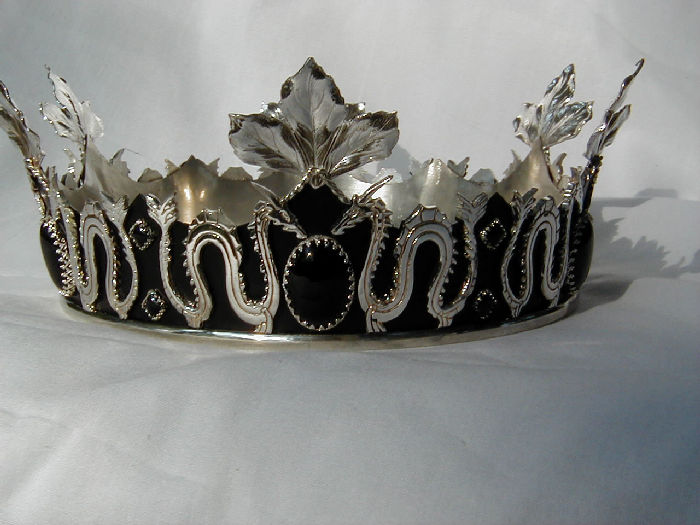
Contents
Mundane definition
A crown is the traditional symbolic form of headgear worn by a monarch or by a deity, for whom the crown traditionally statue power, legitimacy, immortality, righteousness, victory, triumph, resurrection, honour and glory of life after death. In art the crown may be shown being offered to those on Earth by Angels. Apart from the traditional form, crowns also may be made of for example flowers, stars, oak leaves or thorns and be worn by others, representing what the coronation part aims to symbolize with the specific crown.
A coronet is a small crown consisting of ornaments fixed on a metal ring. Unlike a crown, a coronet never has arches. The word stems from the Old French coronete, a diminutive of co(u)ronne ("crown"), itself from the Latin corona (also "wreath").
Traditionally, such headgear is – as indicated by the German equivalent Adelskrone (literally "crown of nobility") – used by nobles and by princes and princesses in their coats of arms, rather than by monarchs, for whom the word crown is customarily reserved in formal English, while many languages have no such terminological distinction. Other than a crown, a coronet shows the rank of the respective noble. Hence, in German language there is also the term Rangkrone.
The Crown in Amtgard
1.Slang for the Monarchy usually of a kingdom.
2. The object itself. A metal band or headdress used to signify station.
Crowning Traditions
At the kingdom level it is the duty of the outgoing Monarch to dismiss their staff; Champion, Regent, Captain of the Guard ect. The Regent should be decrowned last. Then the standing Prime Minister will typically take into custody all the symbols of office for the other positions, and then Finally dismiss the out going monarch. Then the PM crowns the new monarch or the monarch and consort. The new Monarchy then introduce their guard, Champ, Herald, Jester Scribe and any other positions they might have filled.
Each kingdom has it's own traditions and variations. If you are concerned about following the old ways then ask before you chose the order of dismissal and crowning. If not then, hey, it is your reign.
Coronets
Lesser crowns or coronets are sometimes worn by Amtgarders usually at court or some official function. It is considered rude to wear a coronet if you are not a titled noble. It is also considered rude to wear a crown that is above your station or fancier than the Monarchs.
Examples of Crowns
- Lord; Typically a thin band of metal or leather, sometimes having a single point in the center front.
- Baronet; Some what larger than a lord's coronet, almost always having a single point in the front.
- Baron; traditionally bearing six points, topped with pearls as in heraldry. "Pearls" in this case refers to spheres set atop the coronet's rim. They need not be actual pearls, in fact they're often silver.
- Count; Traditionally embattled, or topped with dags.
- Viscount; Kingdoms generally reserve coronets with 12 pearls to Viscounts and Viscountesses
- Marquis; In other organizations Marquis coronets bear strawberry leaves with pearls in between.
- Duke; Often has at least four points, and bears strawberry leaves.
- Archduke; Some use coronets bearing square crosses between strawberry leaves to signify Arch duke.
- Grand Duke; No known designation exists. But from research Grand Duke coronets bear square crosses, between flur de lis.
Coronets in Heraldry and Britan
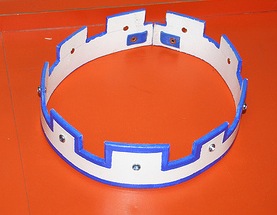
The main use is now actually not on the head (indeed, many people entitled to a coronet never have one made; the same even applies to some Monarchs' crowns, as in Belgium) but as a rank symbol in heraldry, adorning a coat of arms. In the United Kingdom, a peer wears his or her coronet on one occasion only: for a royal coronation, when it is worn along with coronation robes, equally standardized as a luxurious uniform. In the peerage of the United Kingdom, the design of a coronet shows the rank of its owner, as in German, French and various other heraldic traditions.
- The coronet of a duke (a silver-gilt circlet, chased as jewelled but not actually gemmed) has eight strawberry leaves of which five are seen in two-dimensional representations,
- that of a marquess has four strawberry leaves and four silver balls (known as "pearls", but not actually pearls), slightly raised on points above the rim, - of which three leaves and two balls are seen,
- that of an earl has eight strawberry leaves (four visible) and eight "pearls" raised on stalks, of which five are visible,
- that of a viscount has sixteen "pearls" touching one another, nine being seen in representation, and
- that of a baron (a plain silver-gilt circlet) has six "pearls" of which four are visible.
Heraldry with Harold System
This system was introduced through the Amtgard Heraldry Registration Project as a potential system for use by nobility within the context of Amtgard.
- A Lord/Lady's Coronet might be a single band or may have a single peak in the front.
- A Baronet's Coronet might be decorated with a string of pearls displayed on the face of the band with a single peak in the front.
- A Baron/Baroness's Coronet might be decorated with pearls that are displayed immediately on the top of the band.
- A Viscount/Viscountess' Coronet might be decorated with pearls that are raised above the band on individual points.
- A Count/Countess's Coronet might have an embattled top.
- A Marquis's Coronet might be strawberry leaves alternating with pearls displayed above the band.
- A Duke/Duchess's Coronet might be decorated with strawberry leaves displayed above the band.
- An Archduke/Archduchess's Coronet might be decorated with alternating strawberry leaves and fleur-de-lis displayed above the band.
- A Grand Duke/Grand Duchess's Coronet might be decorated with fleur-de-lis displayed above the band.
Since a person entitled to wear a coronet customarily displays it in their coat of arms above the shield and below the helm and crest, this can provide a useful clue as to the owner of a given coat of arms.
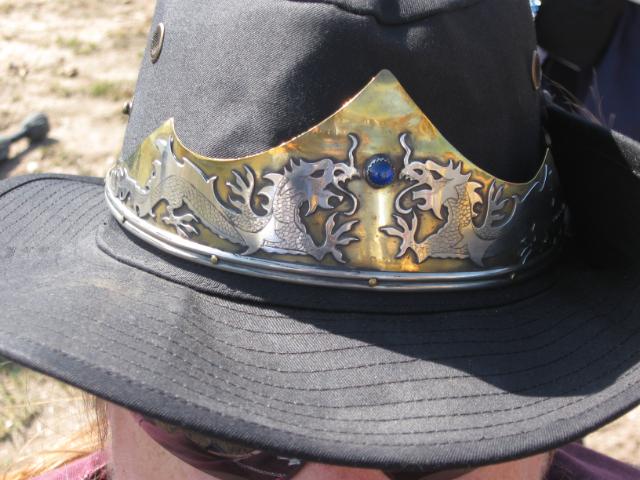
Links
- Knight of the Crown
- How to Circlet, 14th Century
- British crown Jewels replicas
- SCS Coronets
- photo set of SCA coronets
- Brass wire circlets (no longer for sale, but may be a source of inspiration)
- Hinged Coronets (no longer for sale, but may be a source of inspiration)
- Silver wire Circlets (girly) (no longer for sale, but may be a source of inspiration)
